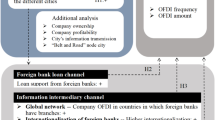Abstract
In this paper, we study the demand of high-tech entrepreneurial ventures for external equity, revealing the conditions that determine whether, when and where they decide to seek external equity during their lives. We also provide evidence on the most important reasons for not looking for external equity at all. We focus on a sample of 530 high-tech entrepreneurial ventures located in 7 European countries and founded between 1984 and 2009. We reveal that company-level characteristics, namely the human capital, the innovativeness, the size, the asset intangibility, and the alternatives to equity capital (internal cash flows and debt) determine whether, when (i.e., at what age) and when (i.e., in international or domestic markets) companies seek external equity. Industry- and country-level variables also play a secondary role in explaining high-tech entrepreneurial ventures’ demand for external equity.


Similar content being viewed by others
Notes
It is worth emphasizing that this issue has also relevant policy implication, especially in Europe. The European Commission has taken several steps to overcome the national barriers to cross-border investment flows, most notably through the introduction of the VC passport (European Commission 2007).
The distribution of survey respondents with respect to survey recipients is similar across foundation periods (χ2(4) = 4.061) but significantly different across countries (χ2(6) = 252.04) and industries (χ2(6) = 14.052). These differences may result in a response bias, which we take in consideration in the robustness check section of the paper.
To reduce retrospective bias and to increase response rates, we decided not to inquire about ventures' seeking behavior on a year-by-year basis. Instead, we collected information on ventures’ external equity-seeking behavior in 5 periods of their early life, which was relatively easy for respondent to identify and remember.
Despite the smaller sample, results are similar when we do not impute missing values in human capital and accounting variables to 0, and are available from the authors upon request.
On the other hand, hybrid quasi-equity forms of public intervention are also easing companies’ access to debt markets (see, e.g., Martí and Quas 2018).
References
Acs, Z. J., Audretsch, D. B., Braunerhjelm, P., & Carlsson, B. (2011). Growth and entrepreneurship. Small Business Economics. https://doi.org/10.1007/s11187-010-9307-2.
Baum, J. A. C., & Silverman, B. S. (2004). Picking winners or building them? Alliance, intellectual, and human capital as selection criteria in venture financing and performance of biotechnology startups. Journal of Business Venturing, 19(3), 411–436. https://doi.org/10.1016/S0883-9026(03)00038-7.
Berger, A. N., & Udell, G. F. (1990). Collateral, loan quality and bank risk. Journal of Monetary Economics, 25(1), 21–42. https://doi.org/10.1016/0304-3932(90)90042-3.
Bertoni, F., Colombo, M. G., & Quas, A. (2015). The patterns of venture capital investment in Europe. Small Business Economics, 45(3), 543–560. https://doi.org/10.1007/s11187-015-9662-0.
Bertoni, F., Colombo, M. G., & Quas, A. (2018b). The role of governmental venture capital in the venture capital ecosystem: an organizational ecology perspective. Entrepreneurship: Theory and Practice, In press, 1–19. https://doi.org/10.1177/1042258717735303
Bertoni, F., D’Adda, D., & Grilli, L. (2016). Cherry-picking or frog-kissing? A theoretical analysis of how investors select entrepreneurial ventures in thin venture capital markets. Small Business Economics, 46(3), 391–405. https://doi.org/10.1007/s11187-015-9690-9.
Bertoni, F., D’Adda, D., & Grilli, L. (2018a). Self-selection of entrepreneurial firms in thin venture capital markets: theory and empirical evidence. Strategic Entrepreneurship Journal, In press. https://doi.org/10.1111/sej.1280.
Bertoni, F., & Groh, A. P. (2014). Cross-border investments and venture capital exits in Europe. Corporate Governance: An International Review, 22(2), 84–99. https://doi.org/10.1111/corg.12056.
Bertoni, F., & Martí, J. (2011). Financing entrepreneurial ventures in Europe: The Vico dataset. SSRN eLibrary. https://doi.org/10.2139/ssrn.1904297.
Brav, O. (2009). Access to capital, capital structure, and the funding of the firm. Journal of Finance, 64(1), 263–308. https://doi.org/10.1111/j.1540-6261.2008.01434.x.
Carpenter, R. E., & Petersen, B. C. (2002). Capital market imperfections, high-tech investment, and new equity financing. Economic Journal, 112(477), F54–F72. https://doi.org/10.1111/1468-0297.00683.
Colombo, M. G., D’Adda, D., & Quas, A. (2018). The geography of Venture Capital: looking at the demand side. Unpublished manuscript.
Colombo, M. G., Delmastro, M., & Grilli, L. (2004). Entrepreneurs’ human capital and the start-up size of new technology-based firms. International Journal of Industrial Organization, 22(8–9), 1183–1211. https://doi.org/10.1016/j.ijindorg.2004.06.006.
Colombo, M. G., & Grilli, L. (2005). Founders’ human capital and the growth of new technology-based firms: A competence-based view. Research Policy, 34(6), 795–816. https://doi.org/10.1016/j.respol.2005.03.010.
Colombo, M. G., & Shafi, K. (2016). Swimming with sharks in Europe: When are they dangerous and what can new ventures do to defend themselves? Strategic Management Journal, Accepted, 1–48.
Cooper, A. C., Gimeno-Gascon, F. J. J., & Woo, C. Y. (1994). Initial human and financial capital as predictors of new venture performance. Journal of Business Venturing, 9(5), 371–395. https://doi.org/10.1016/0883-9026(94)90013-2.
Cosh, A., Cumming, D. J., & Hughes, A. (2009). Outside Entrepreneurial Capital. Economic Journal, 119(1), 494–533. https://doi.org/10.1111/j.1468-0297.2009.02270.x.
Cosh, A., Jin Zhang, J., Bullock, A., & Milner, I. (2011). Open Innovation Choices—What is British Enterprise doing ?
Cumming, D. J., & Macintosh, J. G. (2003). A cross-country comparison of full and partial venture capital exits. Journal of Banking & Finance, 27, 511–548.
Dale, S. B., & Krueger, A. B. (2002). Estimating the payoff to attending a more selective college: An application of selection on observables and unobservables. The Quarterly Journal of Economics, 117(4), 1491–1527. https://doi.org/10.1162/003355302320935089.
Devigne, D., Manigart, S., & Wright, M. (2016). Escalation of commitment in venture capital decision making: Differentiating between domestic and international investors. Journal of Business Venturing, 31(3), 253–271. https://doi.org/10.1016/j.jbusvent.2016.01.001.
ECB. (2017). Survey on the access to finance of enterprises in the euro area: October April to September 2017, (November). https://www.ecb.europa.eu/pub/pdf/other/ecb.accesstofinancesmallmediumsizedenterprises201711.en.pdf?beb1832df4af9efa945a5a1f7b99eeb7
Eckhardt, J. T., Delmar, F., & Shane, S. (2006). Multistage selection and the financing of new ventures. Management Science, 52(2), 220–232. https://doi.org/10.1287/mnsc.1050.0478.
European Commission. (2007). Removing obstacles to cross-border investments by venture capital funds. Brussels. http://ec.europa.eu/enterprise/newsroom/cf/itemdetail.cfm?item_id=2033
EVCA. (2008). Benchmark paper: Benchmarking European tax & legal environments. https://www.investeurope.eu/uploadedFiles/Executive_Summary_Benchmark_2008.pdf
Ferrando, A., Iudice, M., Altomonte, C., Blank, S., Felt, M.-H., Meinen, P., et al. (2015). Assessing the financial and financing conditions of firms in Europe: the financial module in CompNet. European Central Bank Working Paper Series, August(1836), pp. 1–94. https://www.ecb.europa.eu/pub/pdf/scpwps/ecbwp1836.en.pdf
Guerini, M., & Quas, A. (2016). Governmental venture capital in Europe: Screening and certification. Journal of Business Venturing, 31(2), 175–195. https://doi.org/10.1016/j.jbusvent.2015.10.001.
Hall, J., & Hofer, C. W. (1993). Venture capitalists’ decision criteria in new venture evaluation. Journal of Business Venturing, 8(1), 25–42. https://doi.org/10.1016/0883-9026(93)90009-T.
Kaplan, S. N., & Strömberg, P. (2001). Venture capitalists as principals: Contracting, screening, and monitoring. American Economic Review, 91(2), 426–430. https://doi.org/10.3386/w8202.
Katila, R., Rosenberger, J. D., & Eisenhardt, K. M. (2008). Swimming with sharks: technology ventures, defense mechanisms and corporate relationships. Administrative Science Quarterly, 53(2), 295–332. https://doi.org/10.2189/asqu.53.2.295.
Li, Y., & Zahra, S. A. (2012). Formal institutions, culture, and venture capital activity: A cross-country analysis. Journal of Business Venturing, 27(1), 95–111. https://doi.org/10.1016/j.jbusvent.2010.06.003.
Mäkelä, M. M., & Maula, M. V. J. (2005). Cross-border venture capital and new venture internationalization: An isomorphism perspective. Venture Capital, 7(3), 227–257. https://doi.org/10.1080/13691060500258877.
Martí, J., & Quas, A. (2018). A beacon in the night: government certification of SMEs towards banks. Small Business Economics, 50(2), 397–413. https://doi.org/10.1007/s11187-016-9828-4.
Mason, C. M., & Harrison, R. T. (2001). “Investment readiness”: A critique of government proposals to increase the demand for venture capital. Regional Studies, 35(7), 663–668. https://doi.org/10.1080/00343400120075939.
Meuleman, M., Jääskeläinen, M., Maula, M. V. J., & Wright, M. (2017). Venturing into the unknown with strangers: Substitutes of relational embeddedness in cross-border partner selection in venture capital syndicates. Journal of Business Venturing, 32(2), 131–144. https://doi.org/10.1016/j.jbusvent.2017.01.001.
Mina, A., Lahr, H., & Hughes, A. (2013). The demand and supply of external finance for innovative firms. Industrial and Corporate Change, 22(4), 869–901. https://doi.org/10.1093/icc/dtt020.
Myers, S. C. (1984). Capital Structure Puzzle. The Journal of Finance, 39(3), 575–592. http://www.nber.org/papers/w1393. Accessed 26 Sep 2011
Myers, S. C., & Majluf, N. S. (1984). Corporate financing and investment decisions when firms have information that investors do not have. Journal of Financial Economics, 13(2), 187–221. https://doi.org/10.1016/0304-405X(84)90023-0.
Ou, C., & Haynes, G. W. (2006). Acquisition of additional equity capital by small firms—findings from the national survey of small business finances. Small Business Economics, 27(2–3), 157–168. https://doi.org/10.1007/s11187-006-0009-8.
Petty, J. S., & Gruber, M. (2011). “In pursuit of the real deal”. A longitudinal study of VC decision making. Journal of Business Venturing, 26(2), 172–188. https://doi.org/10.1016/j.jbusvent.2009.07.002.
Riding, A. L., Orser, B., & Chamberlin, T. (2012). Investing in R & D: small- and medium- sized enterprise financing preferences. Venture Capital, 14(May), 37–41. https://doi.org/10.1080/13691066.2012.654601.
Robb, A. M., & Robinson, D. T. (2014). The capital structure decisions of new firms. Review of Financial Studies, 27(1), 153–179. https://doi.org/10.1093/rfs/hhs072.
Shane, S., & Cable, D. (2002). Network ties, reputation, and the financing of new ventures. Management Science, 48(3), 364–381. https://doi.org/10.1287/mnsc.48.3.364.7731.
Stuart, T. E., & Sorensen, O. (2003). The geography of opportunity: Spatial heterogeneity in founding rates and the perfromance of biotechnology firms. Research Policy, 32, 229–253.
Tyebjee, T. T., & Bruno, A. V. (1984). A model of venture capitalist investment activity. Management Science, 30(9), 1051–1066. http://www.jstor.org/stable/2631723. Accessed 12 Jan 2011
Tykvová, T., & Schertler, A. (2011). Cross-border venture capital flows and local ties: Evidence from developed countries. The Quarterly Review of Economics and Finance, 51(1), 36–48. https://doi.org/10.1016/j.qref.2010.09.005.
Wright, M., Pruthi, S., & Lockett, A. (2005). International venture capital research: From cross-country comparisons to crossing borders. International Journal of Management Reviews, 7(3), 135–165. https://doi.org/10.1111/j.1468-2370.2005.00113.x.
WSBI-ESBG. (2015). Financial systems in Europe and in the US. Brussels. https://www.wsbi-esbg.org/SiteCollectionDocuments/ Financial systems in Europe and in the US.FINAL.pdf
Zacharakis, A. L., & Meyer, G. D. (1998). A lack of insight: Do venture capitalists really understand their own decision process? Journal of Business Venturing, 13(1), 57–76. https://doi.org/10.1016/S0883-9026(97)00004-9.
Zacharakis, A. L., & Shepherd, D. A. (2001). The nature of information and overconfidence on venture capitalists’ decision making. Journal of Business Venturing, 16(4), 311–332. https://doi.org/10.1016/S0883-9026(99)00052-X.
Acknowledgements
We acknowledge support from the 7th EU Framework Programme VICO project on “Financing Entrepreneurial Ventures in Europe: Impact on Innovation, Employment Growth, and Competitiveness” (Contract no. SSH-2007-1.2.3-G.A. 217485).
Author information
Authors and Affiliations
Corresponding author
Ethics declarations
Conflict of interest
On behalf of all authors, the corresponding author states that there is no conflict of interest.
Rights and permissions
About this article
Cite this article
Quas, A., D’Adda, D. High-tech entrepreneurial ventures seeking external equity: whether, when, where… and why not?. Econ Polit Ind 45, 311–334 (2018). https://doi.org/10.1007/s40812-018-0094-0
Received:
Accepted:
Published:
Issue Date:
DOI: https://doi.org/10.1007/s40812-018-0094-0
Keywords
- High-tech entrepreneurial ventures
- Demand for external equity
- Human capital
- Innovativeness
- External financing




